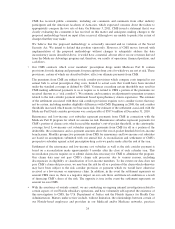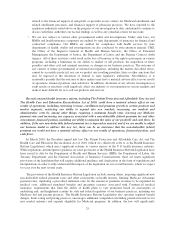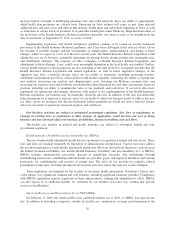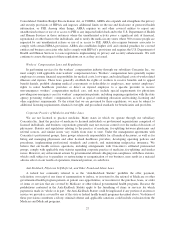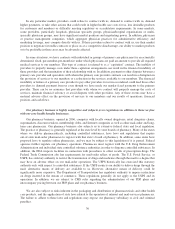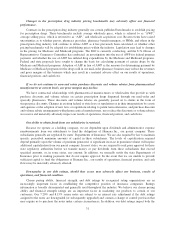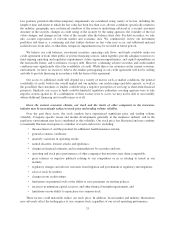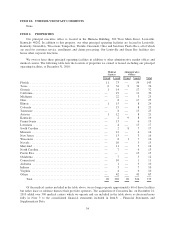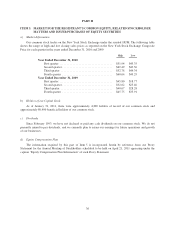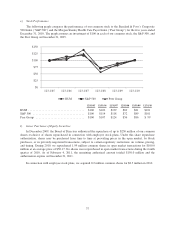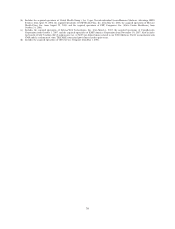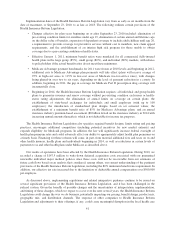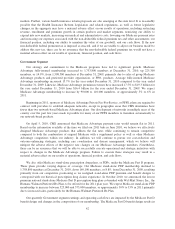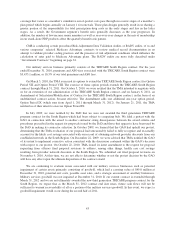Humana 2010 Annual Report Download - page 43
Download and view the complete annual report
Please find page 43 of the 2010 Humana annual report below. You can navigate through the pages in the report by either clicking on the pages listed below, or by using the keyword search tool below to find specific information within the annual report.loss position, potential other-than-temporary impairments are considered using variety of factors, including the
length of time and extent to which the fair value has been less than cost; adverse conditions specifically related to
the industry, geographic area or financial condition of the issuer or underlying collateral of a security; payment
structure of the security; changes in credit rating of the security by the rating agencies; the volatility of the fair
value changes; and changes in fair value of the security after the balance sheet date. For debt securities, we take
into account expectations of relevant market and economic data. We continuously review our investment
portfolios and there is a continuing risk that further declines in fair value may occur and additional material
realized losses from sales or other-than- temporary impairments may be recorded in future periods.
We believe our cash balances, investment securities, operating cash flows, and funds available under our
credit agreement or from other public or private financing sources, taken together, provide adequate resources to
fund ongoing operating and regulatory requirements, future expansion opportunities, and capital expenditures in
the foreseeable future, and to refinance or repay debt. However, continuing adverse securities and credit market
conditions may significantly affect the availability of credit. While there is no assurance in the current economic
environment, we have no reason to believe the lenders participating in our credit agreement will not be willing
and able to provide financing in accordance with the terms of the agreement.
Our access to additional credit will depend on a variety of factors such as market conditions, the general
availability of credit, both to the overall market and our industry, our credit ratings and debt capacity, as well as
the possibility that customers or lenders could develop a negative perception of our long or short-term financial
prospects. Similarly, our access to funds could be limited if regulatory authorities or rating agencies were to take
negative actions against us. If a combination of these factors were to occur, we may not be able to successfully
obtain additional financing on favorable terms or at all.
Given the current economic climate, our stock and the stocks of other companies in the insurance
industry may be increasingly subject to stock price and trading volume volatility.
Over the past three years, the stock markets have experienced significant price and trading volume
volatility. Company-specific issues and market developments generally in the insurance industry and in the
regulatory environment may have contributed to this volatility. Our stock price has fluctuated and may continue
to materially fluctuate in response to a number of events and factors, including:
• the enactment of, and the potential for additional, health insurance reform;
• general economic conditions;
• quarterly variations in operating results;
• natural disasters, terrorist attacks and epidemics;
• changes in financial estimates and recommendations by securities analysts;
• operating and stock price performance of other companies that investors may deem comparable;
• press releases or negative publicity relating to our competitors or us or relating to trends in our
markets;
• regulatory changes and adverse outcomes from litigation and government or regulatory investigations;
• sales of stock by insiders;
• changes in our credit ratings;
• limitations on premium levels or the ability to raise premiums on existing policies;
• increases in minimum capital, reserves, and other financial strength requirements; and
• limitations on our ability to repurchase our common stock.
These factors could materially reduce our stock price. In addition, broad market and industry fluctuations
may adversely affect the trading price of our common stock, regardless of our actual operating performance.
33



